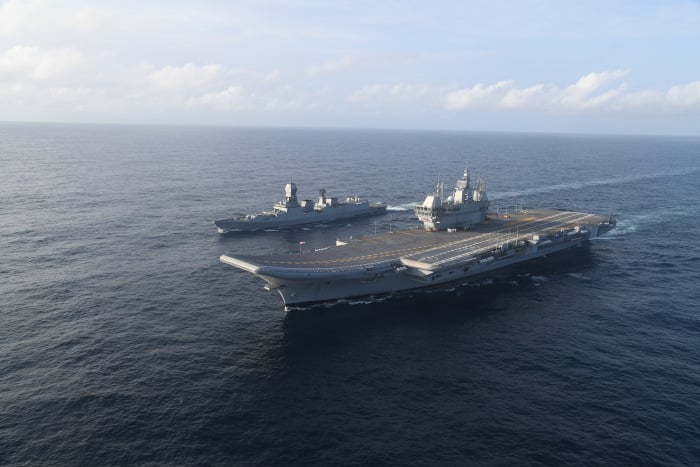“God mode”, for those who aren’t gamers, is a mode of operation (or cheat) built into some types of games based around shooting things. In God mode you are invulnerable to damage and you never run out of ammunition.
First Fighters Land Aboard India’s New Aircraft Carrier INS Vikrant
First Fighters Land Aboard India’s New Aircraft Carrier INS Vikrant
First Fighters Land Aboard India’s New Aircraft Carrier INS Vikrant
An Indian-built light fighter was the first to land aboard and launch from the Indian Navy’s first domestically built aircraft carrier, the service announced this week.
A naval variant of the Hindustan Aeronautics Limited Light Combat Aircraft (LCA) made an arrested landing aboard INS Vikrant (R 11) before then again launching from the carrier’s ski-jump ramp. Later, a Mig-29K aircraft trapped and took off from the carrier.
The demonstration was part of Indian Prime Minister Narendra Modi’s drive for India’s self-reliance known, as “Aatmanirbhar Bharat.”
“The successful landing and take-off of the indigenous LCA Navy on India’s first Indigenous Aircraft Carrier is a momentous step forward towards the realization of our collective vision of Aatmanirbhar Bharat,” Indian Navy Chief of Naval Staff Adm. R. Hari Kumar said in a Tuesday statement.
“The maiden landing of the MiG-29K also heralds the integration of the fighter aircraft with INS Vikrant.”

INS Vikrant. Indian Navy Photo
The 37,000-ton Vikrant will pair with the Russian-built, 45,000-ton Kiev-class INS Vikramaditya (R33) as part of the Indian Navy’s two-carrier force.
“Vikrant is not fitted with a catapult, like U.S. aircraft carriers, but instead features a ski jump and arresting gear to facilitate short take-off but arrested landing of fixed-wing jets,” Eric Wertheim wrote for Proceedings in November.
“The carrier can accommodate up to 30 fixed-wing and rotary-wing aircraft, including a mix of Russian-made MiG-29K fighters and Ka-31 airborne early-warning helicopters, Indian-manufactured Dhruv utility helicopters, and U.S.-produced MH-60R maritime helicopters.”
Vikrant has suffered years of delay and was delivered to the Indian Navy from shipbuilder Cochin Shipyard Limited (CSL) after construction began in 2009, reported USNI News.
The Indian Navy is working on its second domestically built carrier, the planned 65,000-ton Vishal, which is still in the early phases of design. The Indians are also in the midst of acquiring a new fighter for their carrier fleet. Hindustan Aeronautics Limited has proposed creating its own domestic Twin Engine Deck Based Fighter (TEDBF) that could be in production in about ten years. In the interim, the Indian Navy is considering the French Dassault Rafale M and the U.S. Boeing F/A-18E/F Super Hornet Block III. Both have been tested by the service with a land-based ski-jump.
This article was republished from the U.S. Naval Institute under a Creative Commons license. Read the original article.

Sam LaGrone is the editor of USNI News. He has covered legislation, acquisition and operations for the Sea Services since 2009 and spent time underway with the U.S. Navy, U.S. Marine Corps and the Canadian Navy.
Related Articles
Understanding the building blocks for Australia’s quantum future
Australia is undergoing an exciting period of strategic technology policy review and development. The release of its first National Quantum Strategy this week committed the government to building the world’s first error-corrected quantum computer. This is a strategically important technology that has the potential to improve productivity and supply chain efficiency in diverse industries, lower costs across the economy, help reduce carbon emissions and improve public transportation.
Japan needs stronger deterrence than its new defense strategy signals
Since World War II, Japan had long chosen not to possess long-range strike capabilities that could be used against enemy bases. But the Japanese government changed course in December 2022 when it adopted the new national defense strategy (NDS), which included a commitment to acquiring a so-called counterstrike capability. But in order for this new strategy to contribute to deterrence and alter the nation’s defensive role as the ‘shield’ in its alliance with the United States, Tokyo needs to go further than what the NDS outlines.



